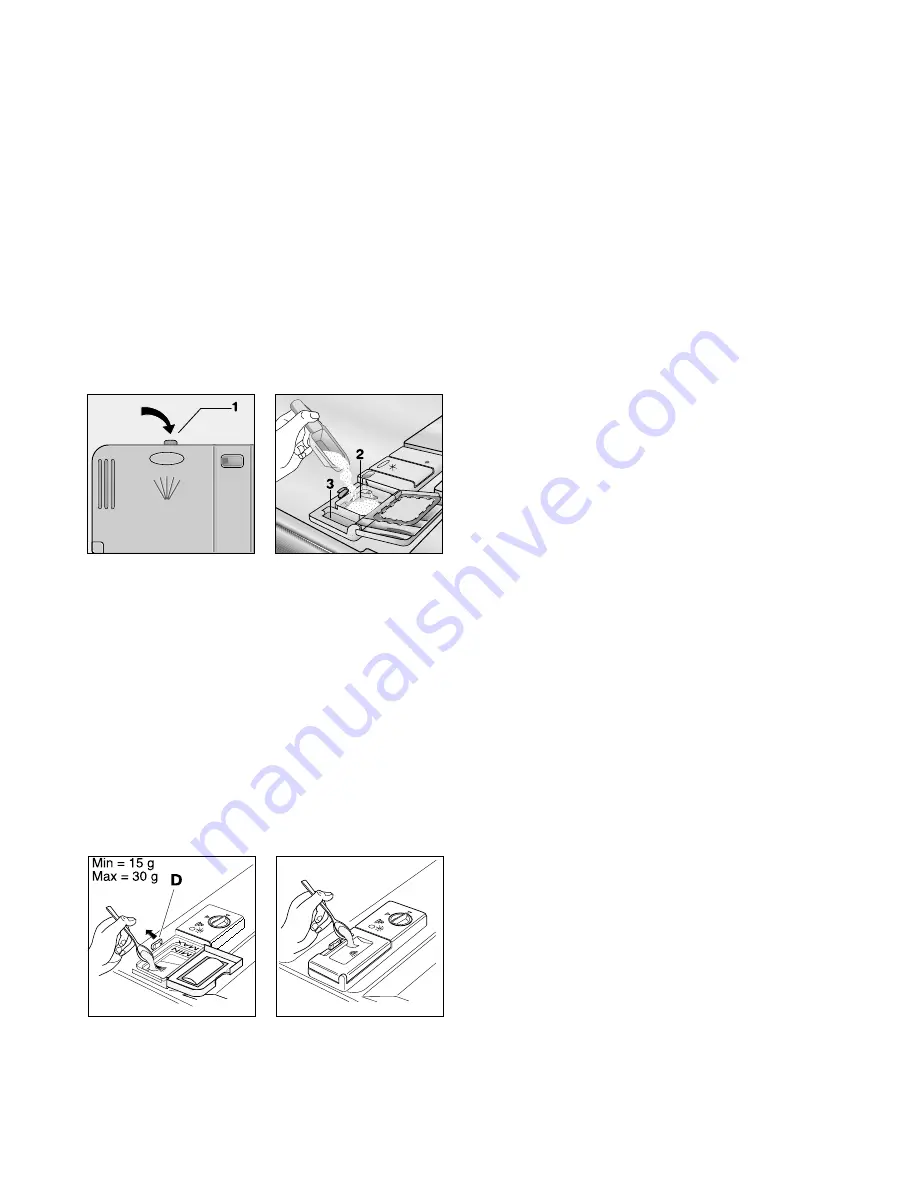
10
Use of detergent
Only use detergents specifically designed for use in
dishwashers.
Using no more then the correct amount of detergent
contributes to reducing pollution.
Prior to the start of a wash programme. The detergent is
released during the washing phase.
Please observe the manufacturer’s dosing and storage
recommendations as stated on the detergent packaging.
Fill with detergent
(Detergent dispenser type A)
1. If the lid is closed: press release button (1). The lid springs
open.
2. Fill the detergent dispenser (2) with detergent.
The marking indicates the dosing levels:
20 = approximately 20 ml of detergent
30 = approximately 30 ml of detergent
3. All programmes with prewash need a little amount of
detergent (5 g) to be added in the adjacent chamber (3).
4. Close the lid and press until it locks in place.
Fill with detergent
(Detergent dispenser type B)
1. If the lid is closed: open the dispenser by pulling the catch
(D). The lid springs open.
2. Fill the detergent dispenser with detergent.
The marking indicates the dosing levels:
Min = approximately 15 g of detergent
Max = approximately 30 g of detergent
3. Close the lid and press until it locks in place.
4. All programmes with prewash need a little amount of
detergent (5 g) to be added over the lid of the dispenser.
Use of "3 in 1" combi detergent tablets
General advice
These products are tablets with combined detergent/rinse-aid
and salt functions.
1. Before using these products you should first check that the
water hardness in your supply is compatible with the use of
these products as per the detergent manufacturers (on the
product packaging).
2. These products should be strictly used according to the
detergent manufacturers instructions.
Do not place the tablets in the tub or in the cutlery
basket as this will result in poorer wash results. The
tablets should be placed in the detergent dispenser.
3. If you encounter problems when using 3 in 1 products for
the first time then please contact the detergent
manufacturers care line (the telephone number is given on
the product packaging).
Special advice
When using combination products, the rinse-aid and salt
indicators are no longer useful. It may be helpful therefore to
switch the rinse aid off - please note that only some
dishwashers have this facility - and select the lowest possible
setting for water hardness.
For more information please refer to the instruction manual.
If you decide to turn back to the use of the standard detergent
system we advise that you:
●
Refill both the salt container and rinse aid dispenser.
●
Switch the water hardness setting to the highest possible
position and run a normal washing programme without a
load.
●
Readjust the water hardness setting again according to the
hardness of the water in your area.
Concentrated detergent
Based on their chemical composition, dishwasher detergents
can be split into two basic types:
- conventional, alkaline detergents with caustic components.
- low alkaline concentrated detergents with natural enzymes.
The use of 50°C washing programmes in conjunction with
concentrated detergents reduces pollution and is good for your
dishes; these wash programmes are specially matched to the
dirt-dissolving properties of the enzymes in the concentrated
detergent. For this reason 50°C wash programmes in which
concentrated detergents are used can achieve the same
results that can otherwise only be achieved using 65°C
programmes.
Detergent tablets
Detergent tablets of different brands dissolve at different
speeds. For this reason some detergent tablets cannot
develop their full cleaning power during short programmes.
Therefore please use normal programmes with prewash when
using detergent tablets.
DE19
DE22
DE17
DE02
Summary of Contents for ESF6121
Page 1: ...D i s h w a s h e r Instruction book Model ESF 6121 GB ...
Page 19: ......






































